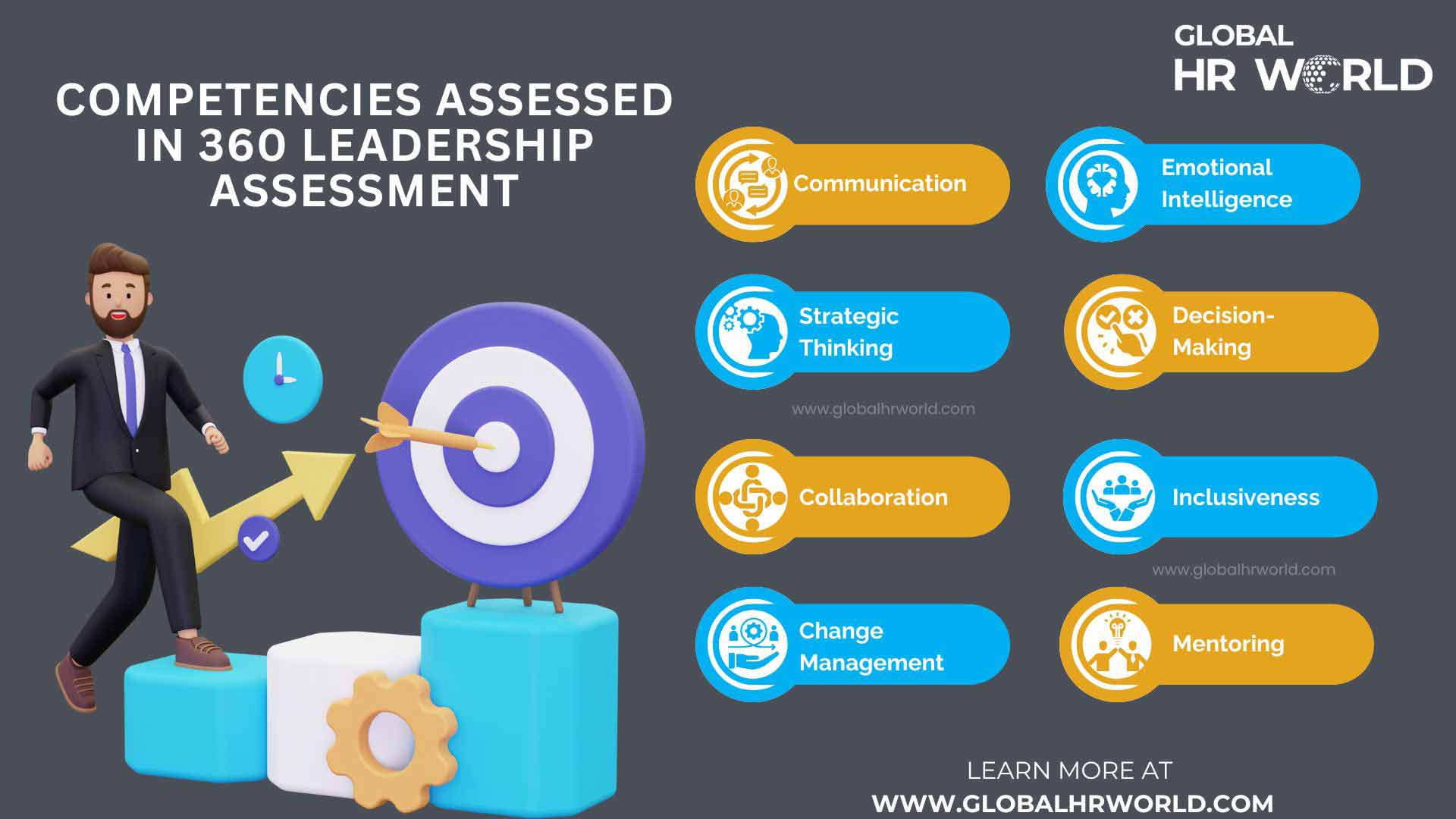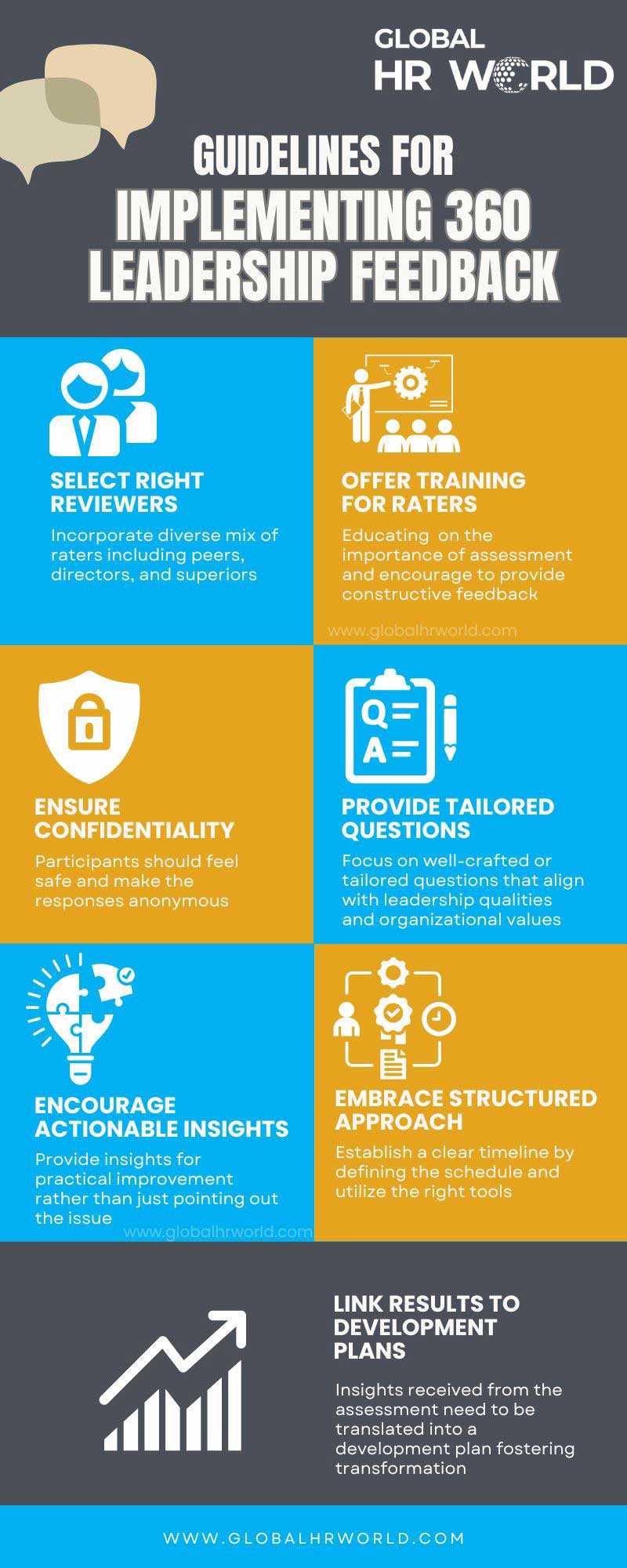360 leadership assessment is one of the most powerful tools for developing great leaders. A strong leader recognizes their strengths and weaknesses and takes intentional steps to overcome limitations by applying effective strategies. This article offers insights into what a 360 leadership assessment really is, which core competencies it measures, the benefits it can offer, and guidelines for organizations to implement 360 leadership assessment effectively.
Understanding 360 Leadership Assessment
The term ‘360’ is used to describe a full-circle, complete or well-rounded view. In the context of leadership assessment, it refers to a full-circle perspective or multiple-source feedback. So, 360 leadership assessment can be considered a feedback tool that assesses a leader’s performance by gathering multi-source input including peers, direct reports, and superiors preventing a single viewpoint.
The assessment aims to offer a comprehensive view of how the leader is perceived across different levels of the organization. The major difference 360 leadership assessment has with employee assessment is the latter is used for performance reviews while the former is used for developmental purposes. By conducting a 360 leadership assessment, various stakeholders associated with the organization are benefitted including the leader themselves, the entire team, peers and direct reports, HR, and the L&D professionals.
Competencies Assessed in 360 Leadership Assessment
Having gathered insights on what 360 leadership assessment is, let’s delve into the major competencies evaluated in the assessment. Although all these competencies differ in degrees for different leaders or not all competencies are present in a single leader, the effectiveness of leadership is dependent on the leader’s understanding of their abilities and areas of improvement. The different competencies evaluated in the 360 leadership assessment are:

- Communication: How effectively the leader delivers messages, persuades others, and actively listens to the team members.
- Emotional Intelligence: The leader’s possession of self-awareness, self-regulation, social awareness, and relationship management.
- Strategic Thinking: The vision of the leader is to see the big picture, anticipate in advance future changes, put forward solutions with a long-term view, prioritize resources, and align actions with organizational goals.
- Decision-Making: The ability to analyze situations and make informed, timely choices.
- Collaboration: The leader’s readiness to ask for input and ability to work as a team.
- Inclusiveness: The ability to create an environment where all employees, regardless of their roles, backgrounds, identities, or perspectives are valued and offered a sense of belongingness.
- Change Management: Adaptability and resilience of the leaders to guide teams through transitions and maintain composure under high-pressure situations.
- Mentoring: The efficiency of talent development, knowledge transfer, constructive feedback, and fostering a culture of growth.
Benefits of 360 Leadership Assessment
The major factor that makes 360 leadership assessment critical is the unique opportunity for leaders to see themselves through the eyes of supervisors, direct reports, and peers. Let’s now analyze the benefits of conducting 360 leadership assessments.
Increased Self-Awareness
With 360 leadership assessment, leaders gain a deeper insight into their strengths, weaknesses, blindspots, and how they approach things from multiple perspectives. This realization is crucial to encourage leaders to adapt their leadership style to better connect with the team.
Leadership Effectiveness
When leaders generate self-awareness, they pave the way for leadership effectiveness. A truthful portrayal of their biases, emotional triggers, and thought patterns, encouraging objective and well-balanced decisions and handling every situation effectively.
Multi-faceted Feedback
Collecting feedback from multiple sources offers leaders an unbiased image of how they are perceived at different levels within the organization. These valuable insights help the leaders create a positive and productive work environment,
Culture of Continuous Improvement
Leaders reassess and refine their strategies on identifying the blind spots that may hinder leadership effectiveness. 360 leadership assessment fosters a culture of continuous improvement by encouraging leaders to set an example before others and promoting learning and elevated performance.
Succession Planning
Succession planning refers to a “business strategy companies use to pass leadership roles down to another employee or group of employees.” Honest and open analysis of leadership roles helps organizations identify potential leaders.
Overall Organizational Performance
By strengthening leadership effectiveness and fostering a culture of continuous improvement, employee engagement and productivity are enhanced contributing to performance that supports long-term growth and engagement.
Guidelines for Implementing 360 Leadership Assessment
Implementing 360 leadership assessment is not about gathering feedback about leadership effectiveness, but a thoughtful approach to ensuring accurate insights leading to overall progression. Here are some of the guidelines to be followed while implementing the assessment.
Select the Right Reviewers
Incorporating diverse perspectives that offer a comprehensive view of the leadership is necessary which demands a diverse mix of raters including peers, directors, and superiors. Moreover, this encourages selecting individuals who can offer honest reviews rather than biased feedback.
Offer Training for Raters
Many professionals are unaware of the importance of the assessment and may deny or fail to provide accurate answers. This can be resolved by educating raters on the importance of 360 leadership assessment and encouraging them to provide constructive feedback.
Ensure Confidentiality
Candidates participating in the assessment may doubt the aftermath of how offering honest feedback results. This requires participants to feel safe and make the responses anonymous by utilizing third-party survey platforms or grouping feedback. However, anonymity should not be used as a shield for unfair criticism about the leader.
Provide Tailored Questions
Avoiding generic or vague questions and focusing on well-crafted or tailored questions that align with leadership qualities and organizational values is imperative while implementing 360 leadership assessment. The questions should align with leadership competencies, be customized for different rater groups, and include a mix of various question types.
Encourage Actionable Insights
A well-executed 360 leadership assessment is not limited to offering strengths and weaknesses but offers actionable insights on improvement. The reviewers should be encouraged to provide insights for practical improvement rather than just pointing out the issue.
Embrace a Structured Approach
Establishing a clear timeline by defining the schedule and utilizing the right tools contributes to an effective and impactful assessment that drives continuous improvement.
Link Results to Development Plans
The insights received from the assessment need to be translated into a development plan fostering transformation. Leaders can create personalized growth roadmaps aligning with their competencies and organizational goals.
Conclusion
A 360 leadership assessment is a powerful tool for fostering self-awareness, leadership effectiveness, and organizational growth. By collecting multi-source feedback, leaders gain a holistic view of their strengths, weaknesses, and blind spots, enabling them to adapt their strategies, refine their leadership styles, and drive continuous improvement. The assessment evaluates key leadership competencies, including communication, emotional intelligence, strategic thinking, decision-making, collaboration, inclusiveness, change management, and mentoring.
The benefits of 360 assessments extend beyond individual development by contributing to increased self-awareness, leadership effectiveness, providing multi-faceted feedback, fostering a culture of learning, succession planning, and enhanced organizational performance. By implementing structured guidelines, such as selecting the right reviewers, training the reviewers, ensuring confidentiality, using tailored questions, encouraging actionable insights, embracing a structured approach, and linking results to development plans, organizations can maximize the impact of these assessments. When executed effectively, 360 leadership assessments empower leaders to grow, teams to thrive, and businesses to succeed, promoting a workplace culture of excellence and innovation.
Infographic

Knowledge Check!
Frequently Asked Questions (FAQs)
What is 360 leadership assessment?
360 leadership assessment can be considered a feedback tool that assesses a leader’s performance by gathering multi-source input including peers, direct reports, and superiors preventing a single viewpoint.
What are the benefits of 360 leadership assessment?
The benefits of 360 assessments extend beyond individual development by contributing to increased self-awareness, leadership effectiveness, providing multi-faceted feedback, fostering a culture of learning, succession planning, and enhanced organizational performance.



